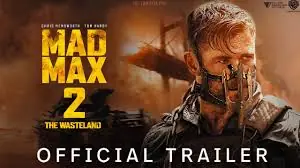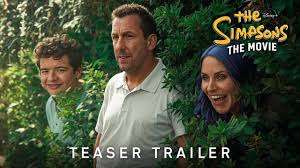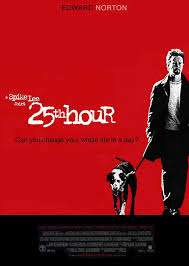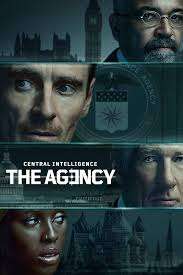Introduction
Damien Power’s Killing Ground (2017) is an unflinching, brutal entry into the survival horror genre that leaves a lasting impression. Set against the backdrop of an isolated Australian camping site, the film follows two couples whose peaceful getaway turns into a nightmare when they cross paths with a pair of ruthless hunters. Blending elements of psychological terror, visceral violence, and a non-linear narrative structure, Killing Ground distinguishes itself from conventional horror films by refusing to shy away from the grim realities of human savagery.
While the film may draw comparisons to classics like Wolf Creek (2005) or The Texas Chain Saw Massacre (1974), it carves out its own identity through its fragmented storytelling and unrelenting tension. This review will explore the film’s narrative structure, character dynamics, thematic depth, and technical execution, ultimately assessing its place within the horror genre.
Plot Summary (Spoiler-Free)
The film opens with an engaged couple, Sam (Harriet Dyer) and Ian (Ian Meadows), arriving at a remote lakeside camping spot for a New Year’s getaway. The serene wilderness initially seems idyllic, but their sense of security is shattered when they discover an abandoned tent nearby. As they investigate, the film shifts between their perspective and that of another family—Margaret (Maya Stange), Rob (Julian Garner), their teenage daughter Em (Tiarnie Coupland), and their baby—who had camped in the same location days earlier.

Through this fractured timeline, the audience gradually pieces together the horrifying fate of the first family while witnessing Sam and Ian’s own descent into terror. The antagonists, German (Aaron Pedersen) and Chook (Aaron Glenane), are introduced as seemingly harmless locals before revealing their true, monstrous nature. What follows is a relentless game of cat-and-mouse, where survival becomes the only objective.
Narrative Structure & Pacing
One of Killing Ground’s most striking features is its non-linear storytelling. Rather than unfolding chronologically, the film jumps between Sam and Ian’s ordeal and the earlier events involving Margaret’s family. This approach creates a sense of dread, as the audience is aware of the impending danger long before the protagonists are. The tension is amplified by the knowledge that the first family’s fate could easily become Sam and Ian’s.
However, this structure also presents a challenge. Some viewers may find the timeline confusing at first, particularly as the film doesn’t immediately clarify the relationship between the two sets of characters. Yet, as the pieces fall into place, the narrative gains momentum, culminating in a harrowing climax that ties both timelines together.
The pacing is deliberate, with a slow-burn first act that lulls the audience into a false sense of security before descending into chaos. While some may argue that the film takes too long to reach its violent peak, the gradual buildup makes the eventual brutality all the more impactful.
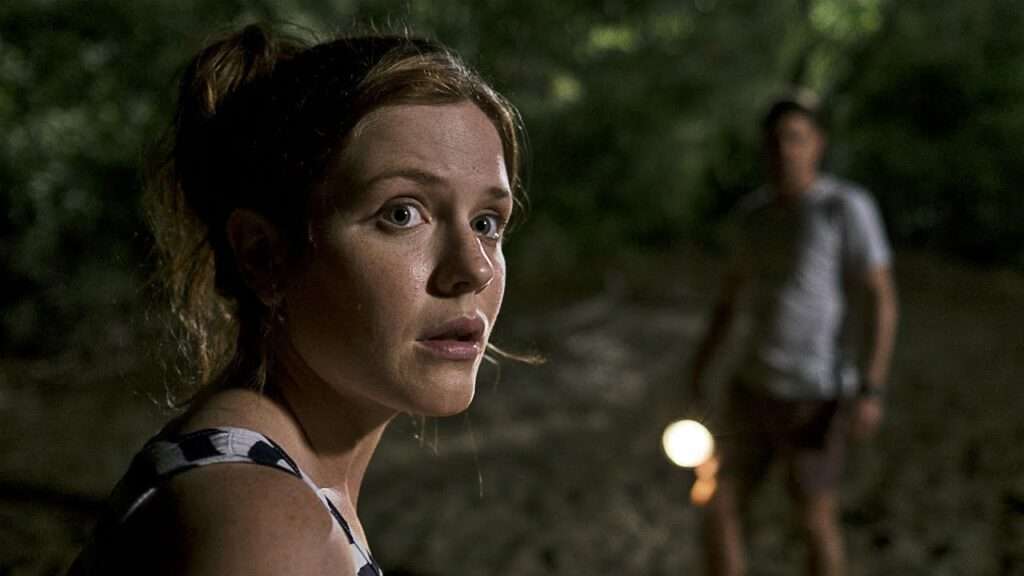
Characters & Performances
The film’s characters are its emotional core, and the performances elevate the material beyond mere exploitation.
- Sam (Harriet Dyer) – As the film’s primary protagonist, Sam is intelligent and resourceful, but not unrealistically so. Dyer portrays her with a grounded vulnerability, making her fight for survival feel authentic.
- Ian (Ian Meadows) – Ian is more cautious and pragmatic, but his decisions sometimes backfire, adding to the tension. Meadows delivers a believable performance as a man pushed to his limits.
- German (Aaron Pedersen) – Pedersen’s portrayal of German is chilling in its understated menace. Unlike cartoonish slasher villains, German exudes a quiet, almost mundane evil, making him all the more terrifying.
- Chook (Aaron Glenane) – In contrast, Chook is more overtly sadistic, serving as the unpredictable wildcard. Glenane balances brutality with moments of dark humor, creating a villain who is both repulsive and strangely charismatic.
The family in the alternate timeline—Margaret, Rob, and Em—also deliver strong performances, particularly Tiarnie Coupland as Em, whose struggle adds an extra layer of tragedy to the film.
Themes & Social Commentary
Killing Ground isn’t just a straightforward survival horror—it’s a meditation on violence, morality, and the fragility of civilization.
1. The Banality of Evil
German and Chook aren’t supernatural monsters; they’re ordinary men capable of extraordinary cruelty. Their casual brutality reflects real-world horrors, forcing the audience to confront the fact that such predators exist.
2. Survival & Moral Compromise
The film doesn’t glorify its protagonists as infallible heroes. Both Sam and Ian make desperate, morally ambiguous choices, highlighting how quickly ethics can unravel in life-or-death situations.
3. Nature vs. Humanity
The Australian wilderness is both beautiful and indifferent—a neutral backdrop to human atrocities. Unlike traditional horror films where nature itself is malevolent, Killing Ground suggests that the true horror comes from people, not the environment.
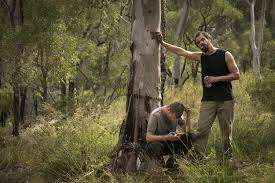
Cinematography & Direction
Damien Power’s direction is confident, using the natural landscape to amplify the film’s tension. Wide shots of the sprawling bushland create a sense of isolation, while tight close-ups during intense moments heighten the claustrophobia. The violence is graphic but not gratuitous; every act of brutality serves the story’s emotional weight.
The cinematography by Simon Chapman (The Babadook, Cargo) is stark and immersive, contrasting the serene beauty of the setting with the ugliness of the events unfolding within it. The use of natural lighting enhances the realism, making the horror feel uncomfortably tangible.
Sound Design & Score
The film’s sound design is minimal but effective. The absence of a traditional horror score in many scenes makes the silence itself unnerving. When music does appear—such as the haunting, discordant strings during key moments—it underscores the terror without overpowering it.
The ambient sounds of the bush—crickets, wind, distant animal calls—contribute to the atmosphere, making the sudden eruptions of violence even more jarring.
Comparisons to Other Horror Films
Killing Ground inevitably draws comparisons to other wilderness horror films:
- Wolf Creek (2005) – Both films feature Australian outback settings and sadistic hunters, but Killing Ground’s non-linear approach sets it apart.
- The Strangers (2008) – Like The Strangers, this film explores the randomness of violence, though Killing Ground is more grounded and less stylized.
- Eden Lake (2008) – The British horror film Eden Lake shares similar themes of middle-class outsiders facing working-class brutality, but Killing Ground avoids overt class commentary, focusing instead on primal survival.
Criticisms & Flaws
While Killing Ground is a strong film, it isn’t without flaws:
- Pacing Issues – The slow first half may test some viewers’ patience, though it pays off in the second act.
- Underdeveloped Antagonists – While German and Chook are terrifying, their motivations remain vague. Some may appreciate the ambiguity, while others might crave more depth.
- Graphic Content – The film’s unflinching violence, particularly involving a baby, will understandably alienate some audiences.
Final Verdict
Killing Ground is not an easy watch, nor is it meant to be. It’s a grim, unrelenting survival horror that refuses to offer cheap thrills or easy resolutions. Damien Power’s direction, strong performances, and innovative narrative structure elevate it above many of its genre counterparts.
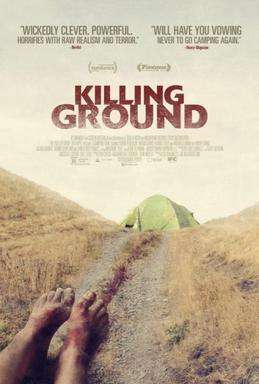
Rating: 8/10
- Strengths: Tense atmosphere, strong performances, effective non-linear storytelling.
- Weaknesses: Slow start, extreme violence may be off-putting for some.
Who Should Watch It?
Fans of gritty, realistic horror films like Wolf Creek or Eden Lake will appreciate Killing Ground. However, those sensitive to graphic violence or distressing subject matter should approach with caution.
Final Thought
Killing Ground lingers long after the credits roll—a testament to its power as a horror film that doesn’t just scare, but unsettles on a deeper level. It may not be a crowd-pleaser, but it’s a bold, unforgettable entry into the genre.

